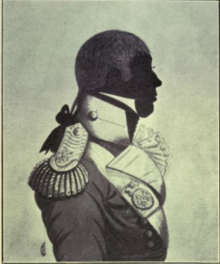Nova Scotia Fencibles



| Part of a series on the | ||||||||||||||||||||||||||||||||||||||||||||||||||||
| Military history of Nova Scotia | ||||||||||||||||||||||||||||||||||||||||||||||||||||
|---|---|---|---|---|---|---|---|---|---|---|---|---|---|---|---|---|---|---|---|---|---|---|---|---|---|---|---|---|---|---|---|---|---|---|---|---|---|---|---|---|---|---|---|---|---|---|---|---|---|---|---|---|
 Citadel Hill in Halifax | ||||||||||||||||||||||||||||||||||||||||||||||||||||
| Notable events
| ||||||||||||||||||||||||||||||||||||||||||||||||||||
| Notable regiments
| ||||||||||||||||||||||||||||||||||||||||||||||||||||
| Related topics | ||||||||||||||||||||||||||||||||||||||||||||||||||||
| ||||||||||||||||||||||||||||||||||||||||||||||||||||
|
The Nova Scotia Fencibles were a military regiment raised in Nova Scotia, Canada, in 1803. The unit had red uniforms with yellow facings.
History
The Nova Scotia Fencibles were the only regiment stationed in Newfoundland in 1812.[2]
Although posted to Kingston in Upper Canada in 1814, the regiment did not see action and was disbanded in 1816.
Half the unit, some 210 officers and other ranks, together with 48 wives and children, were on board the Archduke Charles when it wrecked on 10 June 1816 near Green Island, having cleared the Saint Lawrence River. The Regiment had marched from Kingston to Quebec and had embarked there for Nova Scotia. Four soldiers, two wives, and two children lost their lives; all others were saved. Contemporary accounts referred to the regiment as the Royal Nova Scotia Regiment, which had, however, been disbanded some years earlier.
Notable members
- William Ross, d. 1822, Nova Scotia Fencibles; founder of Ross Farm, Lunenburg County, Nova Scotia
- Colin Alexander McNabb, Lieut. in H.M. late Nova Scotia Fencibles Regt., who departed this life Nov. 10th, 1820.[3]
- Otto Schwartz, Nova Scotia Fencibles
- Colonel Edward Baynes
- Lieutenant Colonel Baylies of the Nova Scotia Fencibles
See also
References
- ^ Grandson of Otto William Schwartz (here)
- ^ Harry Piers, "The Fortieth Regiment, Raised at Annapolis Royal in 1717; And Five Regiments Subsequently Raised in Nova Scotia," Nova Scotia Historical Society (1927), Vol. 21
- ^ Colin Alexander McNabb, Lieut. in H.M. late Nova Scotia Fencibles Regt., who departed this life Nov. 10th, 1820." SERVOS FAMILY BURYING GROUND
- Harry Piers, "The Fortieth Regiment, Raised at Annapolis Royal in 1717; And Five Regiments Subsequently Raised in Nova Scotia," Nova Scotia Historical Society (1927), Vol. 21
- Lieut. General Francis Aug. Wetherall, Colonel of His Majesty's Nova Scotia Regiment of Fencibles ... certify that the bearer hereof ... is hereby discharged ... (1816)
Links
- Regular British and Canadian Regiments in the Canadas











